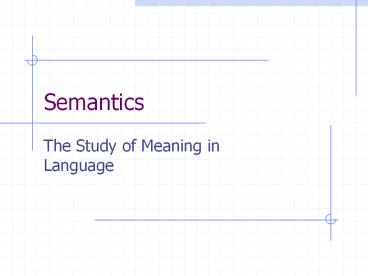Semantics - PowerPoint PPT Presentation
Title:
Semantics
Description:
It deals with the meaning of words (lexical semantics) ... dog: 4-legged mammal, hairy, canine, definitely loyal. COMPOSITIONAL. Dog bites man. ... – PowerPoint PPT presentation
Number of Views:163
Avg rating:3.0/5.0
Title: Semantics
1
Semantics
- The Study of Meaning in Language
2
Semantics Is
- The study of meaning in language.
- It deals with the meaning of words (lexical
semantics). - And how meaning of sentences (compositional
semantics) is derived from words.
3
Principle of Compositionality
- The principle stating that the meaning of a
sentence is determined by the meaning of its
words and by the syntactic structure in which
they are combined. - AKA Freges principle (Gottlob Frege)
4
Lexical vs. Compositional Semantics
- LEXICAL
- man 2-legged mammal, (relatively) hairless, male
sex, - dog 4-legged mammal, hairy, canine, definitely
loyal
- COMPOSITIONAL
- Dog bites man. (happens all the time not too
interesting) - Man bites dog. (newsworthy)
5
Language A multifaceted phenomenon!
- Language meaning communicates information about
the world around us (language as a system of
symbols) - Symbols are things that stand for or refer to
other things. Language with information content. - Meaning is processed in the mind of the
speaker/hearer (that is, cognitive
psychological). - Meaning is a social phenomenon (contexts
important) - Meaning of words/sentences have various
relationships among themselves (antonyms,
synonyms, etc.) (can be studied independently)
6
THEORIES OF MEANING
- Four theories to the meaning of words
- Dictionary meanings
- Mental image
- Referents
- Componential
7
Dictionary Meanings
- demand (N)
- the need or desire that people have for
particular goods or services - desire (N)
- a strong hope or wish
- wish (N)
- the act of wishing for something
- wish (V)
- to hope that something will happen
8
Problems with dictionary meanings
- Understanding meaning of word involves
understanding all the words in definition - Circularity
- pride the quality or state of being proud
- proud feeling or showing pride
9
More problems with dictionary meanings
- They are NOT theoretical claims about the nature
of meaning, but a practical aid to people who
already speak a language. They are usually
paraphrases. - They may be a way of learning the meaning of some
words, but there is much more to word meaning
than the dictionary definition. Why?
10
Mental image
- Is a graphic representation in ones mind of a
referent (when I say table, you "draw" a table in
your mind) - There is much more to meaning than a simple
mental image. Why? - People may have very different mental images for
same word - (lecture from perspective of student vs.
teacher) - Some words, even though having meaning, have no
real definite image - (honesty, or the)
- Mental images are usually a prototype or standard
of the referent - (bird what bird? -- image may exclude atypical
examples)
11
What is the prototype for bird?
12
But bird also includes
13
Advantages of prototype theory
- Provides some insight into the way we conceive of
certain ideas/objects - Evidence from experimental psychology
- reaction time typical member lt atypical member
- Prototypes may help children learn the meanings
of new words
14
Disadvantages of prototype theory
- Culturally and socially dependent.
- prototypes can vary across populations.
- Many words have no clear mental images.
- forget, things, without, concept, ..
15
Referents
- Have to do with the fact that words usually stand
for (refer to) actual objects or relations in the
world. - Example Dubya, Florida, Disney World.
- There is much more to meaning than a referent.
Why? - It would exclude from language fantasies,
speculations, and fiction.(Santa Claus refers to
what?). - The fact that two words (or expressions) refer to
the same thing does not indicate that they mean
the same thing.(Queen Elizabeth Queen of
England in 2005?). - What referents do these words have forget, the,
some?
16
Componential Theory
- The meaning of a word is specified by smaller
semantic components - Semantic components are primitive elements of
meaning expressed as binary features ( or
-)
17
Semantic decomposition
- woman
- human
- female
- adult
- man
- human
- - female
- adult
- girl
- human
- female
- - adult
- boy
- human
- - female
- - adult
18
Advantages of componential theory
- Captures similarities among semantically related
words - Groups meanings into natural classes (like
phonology)
19
Disadvantages of componential theory
- Difficult to analyze abstract concepts
- What are the semantic components of blue?
- color? blueness?
- Meaning of semantic components is sometimes no
more explanatory than the words they are
specifying
20
Meaning relationshipsWithin Lexical Semantics
- There are many ways for words to be related
- Morphologically
- lift lifted (same stem)
- Syntactically
- call take (both transitive verbs)
- Phonologically
- knight night (both naIt
- Semantically
21
Semantic relationships
- Semantic relationships indicate a similarity in
meaning between two words. - crayon and pencil.
- But not pencil and refrigerator, for example.
22
Semantic relationships
- The semantic relationships we will discuss here
are - Hyponymy
- Synonymy
- Antonymy
- Scalar/gradable pairs































